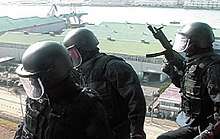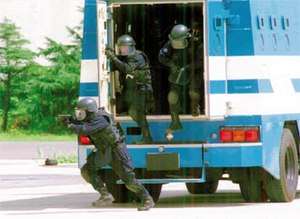Special Assault Team
The Special Assault Teams (特殊急襲部隊, Tokushu Kyūshū Butai) are police tactical units of the Japanese Police. They are established in major prefectural police departments supervised by the National Police Agency.[1]
| Special Assault Teams (特殊急襲部隊, Tokushu Kyūshū Butai) | |
|---|---|
 | |
| Active | 1977-1996 (as Special Armed Police) 1996 – present |
| Country | |
| Branch | Japanese prefectural police departments |
| Type | Police tactical unit |
| Role | Counter-terrorism Law enforcement |
| Size | c. 300 |
| Garrison/HQ | Tokyo (Most SAT operatives) at the Metropolitan Police HQ Osaka Hokkaidō Chiba Kanagawa Aichi Fukuoka Okinawa[1] |
| Nickname(s) | SAT |
The SAT is national-level counter-terrorism asset cooperating with territorial-level Anti-Firearms Squads and Counter-NBC Terrorism Squads.[1] Most information on the unit has been confidential, its existence officially revealed only in 1996. SAT is officially known in Japanese as simply Special Unit (特殊部隊, Tokushu Butai) and individual teams officially take the name of the Metropolitan or Prefectural police departments to which they are assigned; an example would be Tokyo Metropolitan Police Department Special Unit (警視庁特殊部隊, Keishicho Tokushu Butai, Metropolitan Police Department Special Unit) for the SAT unit assigned to the Tokyo Metropolitan Area.
Background
By the mid-1970s, Japanese police already had Special Firearms Squad (特殊銃隊, Tokushu Jūtai), launched as a response to the Kin Kiro Incident in 1968. They were sniper teams basically, and entry teams were also built in the Metropolitan Police Department; these squads were predecessors of the Anti-firearms squads, but they were only part-time SWAT teams at this time.[2]
In response to the Dhaka Incident, the National Police Agency decided to set up full-time anti-terrorism special units at the Tokyo Metropolitan Police Department and the Osaka Prefectural Police Department in secret.[3] The Tokyo unit was established as the Special Company (特科中隊, Tokka-chūtai) of its 6th Riot Police Unit and the Osaka unit as the "Zero" Company of its 2nd Riot Police Unit.[4] The Tokyo unit was nicknamed SAP (Special Armed Police), and it was recognized as the official name around 1982 and the flag was awarded.[5]
In 1996, it was officially announced that the tactical units had been organized, and their unit name were changed to SAT, Special Assault Teams. In addition to the MPD and Osaka, teams in Hokkaido, Kanagawa, Chiba, Aichi, Fukuoka Prefectural Police were also established.[5][6] In 2005, a team of the Okinawa Prefectural Police was established, and existing units were also reinforced.[2]
Organization

Structure
SAT teams are set up at eight Prefectural Police Departments. In most prefectures they belong to the Riot Police Unit, but in the MPD it is directly under its First Security Division, and the Security Division in the Osaka.[6]
Total strength is about 300 officers. It is said that three teams in the Metropolitan Police Department, two teams in the Osaka Prefectural Police Department, and one team in each of the other Prefectural Police are set up. Each team consists of a command section, a entry section, a sniper support section, and a technical support section.[6]
Recruitment and training
Members are recruited from Riot Police Units. When the unit was founded, the members were selected from rangers, rescue specialists, snipers and martial artists.[3] It is said that they will be subject to inspection and inspection for officers under 30 years old.[6] In order to maintain physical strength, the period of service is assumed to be approximately 5 years. Graduates are usually transferred to other departments in the Security Bureau, but some are transferred to the Special Investigation Team (SIT) of the criminal investigation department to introduce their high SWAT capability to the detectives.[7]
Although SAT training is enigmatic, a retired SAP member recalled that Airborne Ranger Courses of the Japan Ground Self-Defense Force, counter-insurgency, and air assault training had been conducted.[8] Nowadays, SAT has training facilities in six locations nationwide, and training at Yumenoshima is sometimes released to reporters.[4] There were also exchanges with overseas police forces, at least with joint training with the German GSG 9.[9] 10 SAT officers were placed under training by Queensland Police's Specialist Service Branch in Queensland, Australia.[10]
Equipment
In addition to standard service handguns, the SAP units used Heckler & Koch P9S pistols as their main sidearms.[8] After being reorganized into SAT, usage of Heckler & Koch USP and Smith & Wesson Model 3913 have been confirmed, there is information that Glock 19, SIG Sauer P226 and Beretta 92 Vertec are adopted.[6][11]
As their mainarms, the SAP unit used Heckler & Koch MP5A5, MP5SD6, MP5K submachine guns.[5] There is also information that SAT units have adopted Howa Type 89 assault rifles and M4 carbines.[6]
Japanese police have adopted Howa Golden Bear, then M1500 as their sniper rifle.[11] Also in the SAP, Howa Type 64 rifle was also used as designated marksman rifles.[8] And in the SAT, Heckler & Koch PSG1 and L96A1 also have been deployed.[11]
SAT teams operate special Heavy Special Armored Vehicle (銃器対策警備車, Jūki-taisaku-keibi-sha) and unmarked bulletproof cars.[4]
Operational history
The "Zero" Company of the Osaka Prefectural Police had its first known incident on January 26, 1979 when they were deployed during a Mitsubishi Bank hostage incident in Osaka. In the incident, they shot dead Akiyoshi Umekawa after he gunned down two employees and two policemen.[9]
As the SWAT ability of other departments improved, the SAT became "last ditch" of the Security Bureau of the National Police Agency, and opportunities to conduct domestic direct action decreased. In the Gulf Crisis of 1990, the SAP unit was dispatched to Saudi Arabia for non-combatant evacuation operation. During the Japanese embassy hostage crisis in Peru, the SAT had simulated raids on retaking buildings similar to the Japanese Embassy as a possible counter-measure to a similar incident in Japanese soil.[9]
On June 21, 1995, All Nippon Airways Flight 857 was hijacked at the Hakodate Airport in Hokkaido by a lone hijacker named Fumio Kutsumi (九津見 文雄).[12] This incident marked the first time that the Japanese Air Self-Defense Forces cooperated with the SAP by providing Kawasaki C-1 aircraft as means of transportation from Haneda Airport.[13] SAP officers assisted Hokkaido Prefectural Police officers entering the plane.[9]
In May 2000, the Osaka and Fukuoka SAT assisted the detectives of the Hiroshima Prefectural Police storm a hijacked bus in Fukuoka in the Neomugicha incident, capturing the lone hijacker alive.[9][14][15]
In September 2003, the Aichi SAT unit was deployed to resolve a hostage incident. However, the hostage-taker Noboru Beppu (別府 昇) committed suicide in an explosion which killed three and injured 41 others.[16]
On September 10, 2005, Okinawa was established for a SAT unit to be operational.[17] According to the NPA, the presence of American troops and the region's geography were taken to consideration to create a unit to be stationed there, especially after Al-Qaeda had made terrorist threats against Japan in the past.[17]
In May 2007, in another hostage case in Nagoya, an ex-yakuza gangster named Hisato Obayashi (大林 久人) was captured after he killed Kazuho Hayashi (林 一歩), an Aichi SAT operative.[18] In this operation, the Aichi SIT was in charge of direct action and the SAT was backing up, but the stray bullets hit the SAT operative.[6] Posthumously promoted to Captain, he is the first SAT officer killed in action.[19] His death has forced National Public Safety Commission Chairman Kensei Mizote to issue a press report, stating that SAT gear will be checked to see if it was responsible for Hayashi's unfortunate death.[20]
The SAT Support Staff (or the SSS) unit was created on May 2007 in the wake of the hostage taking in Aichi Prefecture.[1]
In 2015, Japanese media suggested that the SAT can potentially be dispatched to work alongside officers from the Terrorism Response Team-Tactical Wing for Overseas.[21]
The SAT was deployed in May 2016 at the 42nd G7 summit, providing security alongside the Special Boarding Unit.[22]
See also
- List of Police Tactical Units
References
- "Chapter IV. Maintenance of Public Safety and Disaster Countermeasures" (PDF). Japanese National Police Agency. Archived from the original (PDF) on 2011-03-23. Retrieved 2011-03-25.
- Strike And Tactical Magazine 2017, pp. 60-61.
- Itō 2004, pp. 46-51.
- Strike And Tactical Magazine 2017, pp. 37-45.
- Itō 2004, pp. 105-118.
- Kakitani & Kikuchi 2008, pp. 12-17.
- Itō 2004, pp. 194-198.
- Itō 2004, pp. 69-104.
- Itō 2004, pp. 193-203.
- Michelle Connolly. "Japanese officers put to the test in the Sunshine State" (PDF). Queensland Police. Archived from the original (PDF) on 2009-10-08. Retrieved 2010-01-18.
- Otsuka 2009.
- Michelle McGee (1995-06-22). "Police Raid Ends Japan Hijacking". SFGate. Archived from the original on 2012-11-26. Retrieved 2012-11-16.
- https://flyteam.jp/news/article/65182
- "Riot police end hijack drama". BBC. 2000-05-03. Archived from the original on 2010-08-26. Retrieved 2009-01-26.
- Ryuichiro Hosokawa (2000-05-16). "Failing youth and the victims of crime". The Japan Times. Retrieved 2012-02-09.
- "Three killed, 41 injured in Japan when office worker takes hostages". The Japan Times. 2003-09-18. Retrieved 2012-02-09.
- https://web.archive.org/web/20121001051450/http://www.stripes.com/news/okinawa-police-form-assault-team-for-response-to-terrorism-1.38051
- "Gunman surrenders, ending 29-hour standoff in Nagakute". The Japan Times. 2007-05-19. Retrieved 2012-02-09.
- Aichi standoff ends after shooter gives himself up, May 18, 2007 by Kyodo News.
- "Security chief pledges to reexamine special assault gear after officer's death". The Japan Times. Archived from the original on 2007-10-24. Retrieved 2007-06-18.
- https://www.sankei.com/premium/news/150209/prm1502090004-n3.html
- http://biz-journal.jp/2016/06/post_15327_2.html
Books
- Itō, Kōichi (2004). The truth of the Metropolitan Police Special unit (in Japanese). Dainihon-kaiga. ISBN 978-4499228657.CS1 maint: ref=harv (link)
- Kakitani, Tetsuya; Kikuchi, Masayuki (2008). Japanese counter-terrorism units (in Japanese). Sanshusha Co.,Ltd. ISBN 978-4384042252.CS1 maint: ref=harv (link)
- Strike And Tactical Magazine, ed. (2017). Special forces of Japan (in Japanese). KAMADO. NCID BB01834038.CS1 maint: ref=harv (link)
Articles
- Otsuka, Masatsugu (2009). "Guns of the Japanese police". Strike and Tactical Magazine (in Japanese). KAMADO. 6 (1): 50–57.CS1 maint: ref=harv (link)
External links
| Wikimedia Commons has media related to Special Assault Team. |